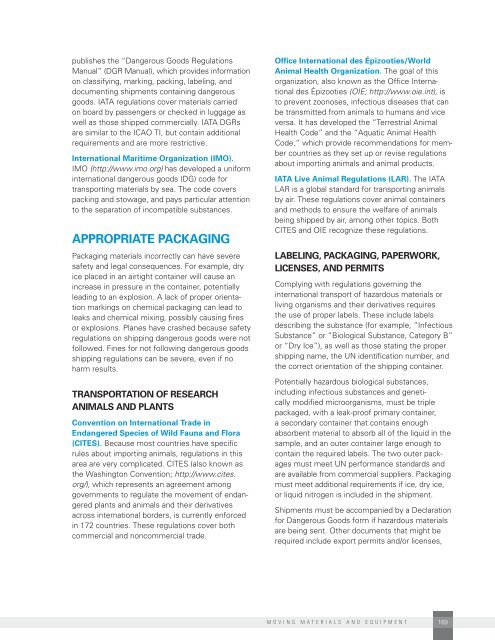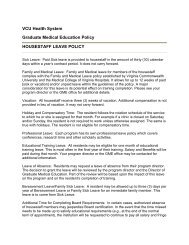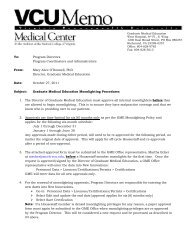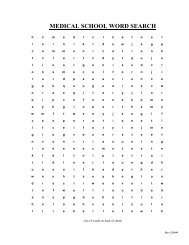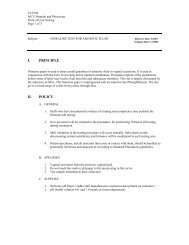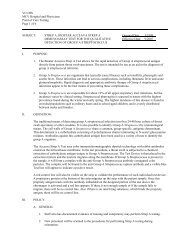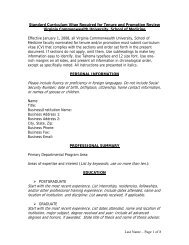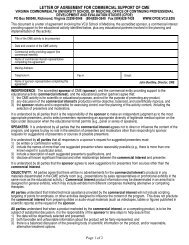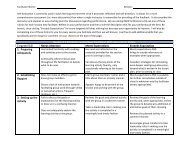paperwork involved in purchasing1. Pro forma invoice/price quote: a quotation on the price (FOB, CIF, or in place) for a product or aseries <strong>of</strong> products. Normally it is valid for a limited time. This document does not certify any realtransaction, but for a time period it establishes the value <strong>of</strong> a trade.2. Invoice: the document that reflects that the real transaction has been formally arranged and willcertainly occur or has occurred.3. Receipt: the document certifying that the payment for the transaction stated in the invoice has beendone. A receipt has no value without the invoice. On the contrary, certain kinds <strong>of</strong> invoices have valuewithout the corresponding receipts. Granting agencies may require the original invoices <strong>of</strong> yourpurchases as pro<strong>of</strong> that the transactions have taken place. In some cases, they might also requestthe receipts or other pro<strong>of</strong>s <strong>of</strong> payment, such as credit card balances, copies <strong>of</strong> wire transfers, etc.4. Packing slip/remito: the document that is signed when the delivery is received at the purchaser’s lab.bioresource centers and at biotechnology companiesthat support science in the developing world,and scientists who work in developing countries.Perhaps the most important single piece <strong>of</strong> adviceis that there is no fixed set <strong>of</strong> rules to learn thatwill allow you to handle shipping yourself—instead,you should identify experts with local knowledgeand experience and enlist those people to handlesuch matters. That being said, it will be useful tohave some background knowledge about relevantregulations and organizations. Additional practicaladvice will be covered in later sections <strong>of</strong> the chapter.Regulations andRelevant OrganizationsThe regulations that govern international shippingare complicated and in flux, affected by politicsand world events. A complete description <strong>of</strong> allapplicable organizations and laws affecting thetransfer <strong>of</strong> materials is well beyond the scope<strong>of</strong> this chapter. The material presented here isintended to be a general overview.Hazardous MaterialsUnited Nations (UN) Model Regulations on theTransport <strong>of</strong> Dangerous Goods. The UN ModelRegulations, although not legally binding, providea foundation for the development <strong>of</strong> globallyharmonious regulations on transporting hazardousmaterials. These regulations are developed bycommittees made up <strong>of</strong> representatives frommany countries. They address a wide variety <strong>of</strong>hazards, including toxicity, radioactivity, infectioussubstance hazards, flammability, explosiveness,and corrosiveness.UN identification numbers are given to specificmaterials ranging from infectious substancesthat affect humans to genetically modifiedmicroorganisms to dry ice. The Model Regulationsprescribe standards for packaging, labeling, andmarking for each category <strong>of</strong> material in transit.They describe the documentation and emergencycontact information required for each shipment.The use <strong>of</strong> consistent regulations internationallyhas obvious benefits, among them obviating theneed to reclassify, re-label, or repackage materialsduring transport.International Civil Aviation Organization(ICAO). The ICAO (http://www.icao.int/), an agency<strong>of</strong> the UN, publishes “Technical Instructions on theSafe Transport <strong>of</strong> Dangerous Goods by Air” (ICAOTI) biannually. These instructions are in part basedon the UN Recommendations described above.International Air Transport Association (IATA)The IATA (http://www.iata.org) is a global tradeorganization that was formed over 60 yearsago and now represents 250 airlines. The IATA168 excellence everywhere
publishes the “Dangerous Goods RegulationsManual” (DGR Manual), which provides informationon classifying, marking, packing, labeling, anddocumenting shipments containing dangerousgoods. IATA regulations cover materials carriedon board by passengers or checked in luggage aswell as those shipped commercially. IATA DGRsare similar to the ICAO TI, but contain additionalrequirements and are more restrictive.International Maritime Organization (IMO).IMO (http://www.imo.org) has developed a uniforminternational dangerous goods (DG) code fortransporting materials by sea. The code coverspacking and stowage, and pays particular attentionto the separation <strong>of</strong> incompatible substances.appropriate packagingPackaging materials incorrectly can have severesafety and legal consequences. For example, dryice placed in an airtight container will cause anincrease in pressure in the container, potentiallyleading to an explosion. A lack <strong>of</strong> proper orientationmarkings on chemical packaging can lead toleaks and chemical mixing, possibly causing firesor explosions. Planes have crashed because safetyregulations on shipping dangerous goods were notfollowed. Fines for not following dangerous goodsshipping regulations can be severe, even if noharm results.Transportation <strong>of</strong> ResearchAnimals and PlantsConvention on International Trade inEndangered Species <strong>of</strong> Wild Fauna and Flora(CITES). Because most countries have specificrules about importing animals, regulations in thisarea are very complicated. CITES (also known asthe Washington Convention; http://www.cites.org/), which represents an agreement amonggovernments to regulate the movement <strong>of</strong> endangeredplants and animals and their derivativesacross international borders, is currently enforcedin 172 countries. These regulations cover bothcommercial and noncommercial trade.Office International des Épizooties/WorldAnimal Health Organization. The goal <strong>of</strong> thisorganization, also known as the Office Internationaldes Épizooties (OIE; http://www.oie.int), isto prevent zoonoses, infectious diseases that canbe transmitted from animals to humans and viceversa. It has developed the “Terrestrial AnimalHealth Code” and the “Aquatic Animal HealthCode,” which provide recommendations for membercountries as they set up or revise regulationsabout importing animals and animal products.IATA Live Animal Regulations (LAR). The IATALAR is a global standard for transporting animalsby air. These regulations cover animal containersand methods to ensure the welfare <strong>of</strong> animalsbeing shipped by air, among other topics. BothCITES and OIE recognize these regulations.Labeling, Packaging, Paperwork,Licenses, and PermitsComplying with regulations governing theinternational transport <strong>of</strong> hazardous materials orliving organisms and their derivatives requiresthe use <strong>of</strong> proper labels. These include labelsdescribing the substance (for example, “InfectiousSubstance” or “Biological Substance, Category B”or “Dry Ice”), as well as those stating the propershipping name, the UN identification number, andthe correct orientation <strong>of</strong> the shipping container.Potentially hazardous biological substances,including infectious substances and geneticallymodified microorganisms, must be triplepackaged, with a leak-pro<strong>of</strong> primary container,a secondary container that contains enoughabsorbent material to absorb all <strong>of</strong> the liquid in thesample, and an outer container large enough tocontain the required labels. The two outer packagesmust meet UN performance standards andare available from commercial suppliers. Packagingmust meet additional requirements if ice, dry ice,or liquid nitrogen is included in the shipment.Shipments must be accompanied by a Declarationfor Dangerous Goods form if hazardous materialsare being sent. Other documents that might berequired include export permits and/or licenses,moving materials and equipment169
- Page 3 and 4:
A R e s o u r c e f o r S c i e n t
- Page 5 and 6:
Table of ContentsVII119PrefaceChapt
- Page 7:
135 Chapter 10E x p a n d i n g Y o
- Page 15 and 16:
Q u e s t i o nq&aWhat Is a “Tenu
- Page 17:
preparing for immediate submission,
- Page 22 and 23:
Practicing the Talkn Practice your
- Page 24 and 25:
your one-on-one interviews you have
- Page 26 and 27:
If talking directly about money is
- Page 28 and 29:
When the institution responds and y
- Page 30 and 31:
equipment and supplies. Maintenance
- Page 32 and 33:
Q u e s t i o nq&aIs your instituti
- Page 34 and 35:
Working With Human SubjectsWhether
- Page 36 and 37:
RESPONSIBILITIES BEYONDTHE LABORATO
- Page 38 and 39:
UNDERSTANDING YOURINSTITUTION AND H
- Page 40:
Criteria for PromotionStructure of
- Page 45 and 46:
Q u e s t i o nWhat’s in a Name?q
- Page 47 and 48:
Screening ApplicantsWhen you review
- Page 50 and 51:
Interpersonal Skillsn How important
- Page 52 and 53:
Multinational Organizations are hir
- Page 54 and 55:
n If there is an office that handle
- Page 57 and 58:
n Seek funding and publish papers (
- Page 59 and 60:
In fact, even though you yourself h
- Page 61 and 62:
n Craft a statement that you feel c
- Page 63 and 64:
n When you delegate authority to so
- Page 65 and 66:
n Use only pens, preferably with wa
- Page 67 and 68:
Strategy sessionsShould you decide
- Page 69 and 70:
Finding Good Papers for Journal Clu
- Page 71 and 72:
If possible, invite people in your
- Page 73 and 74:
Q u e s t i o nq&aHow do I avoid po
- Page 75 and 76:
The International Committee of Medi
- Page 77 and 78:
Managing Conflictin the LabConflict
- Page 79 and 80:
steps for dealing with conflictWhen
- Page 81 and 82:
chapter 5managing your time“ Succ
- Page 83 and 84:
Check your work: the 90-year though
- Page 85 and 86:
n Make and keep appointments with y
- Page 87 and 88:
n Help them seek advice without tak
- Page 89 and 90:
FAMILY MATTERSMany scientists face
- Page 91 and 92:
chapter 6project management“ We m
- Page 93 and 94:
My project is to get a grant funded
- Page 95:
ObjectivesObjectives are the end re
- Page 98 and 99:
The key events schedule and the act
- Page 100 and 101:
Microsoft Project, a program that s
- Page 102 and 103:
Martin, Vivien. Managing Projects i
- Page 104 and 105:
appendix II: Example of a Work Brea
- Page 106 and 107:
appendix iv: Example of a Gantt Cha
- Page 108 and 109:
e h i n d c l o s e d d o o r s :w
- Page 110 and 111:
Who might be interested in supporti
- Page 112 and 113:
Call your program officerProgram of
- Page 114 and 115:
direct costs vs. indirect costsDire
- Page 116 and 117:
RESOURCESAllen, Ernest M. “Why ar
- Page 118 and 119:
the next generation of students (th
- Page 120 and 121:
Seek Feedback through a Formal Peer
- Page 122 and 123:
Encouraging Student Questionsn Do n
- Page 124 and 125:
Here are some ways you can help the
- Page 126 and 127:
n Are there curriculum changes unde
- Page 128 and 129: a relaxed format for talking about
- Page 130 and 131: spend in preparing an effective cou
- Page 132 and 133: The Publishing ProcessTypes of Jour
- Page 134 and 135: A word about impact factorsThe impa
- Page 136 and 137: C r e a t i n g a n i n t e g r a t
- Page 138 and 139: may need to take the first author p
- Page 140 and 141: submitting image filesToday, most i
- Page 142 and 143: Submitting your Paper to Another Jo
- Page 144 and 145: RESOURCESDavis, Martha. Scientific
- Page 146 and 147: increase your impact as a scientist
- Page 148 and 149: Q u e s t i o nq&aHow do I communic
- Page 150 and 151: n Offer criticism and correction in
- Page 152 and 153: It is important to discuss career g
- Page 154 and 155: When Mentoring,Advisory, or Supervi
- Page 156 and 157: For researchers in developing count
- Page 158 and 159: n Is travel safe and convenient, or
- Page 160 and 161: n The expected contribution of each
- Page 162 and 163: Meetings. Set up systems to ensure
- Page 164 and 165: SPECIAL CHALLENGESFOR THE BEGINNING
- Page 166 and 167: e an important connection to future
- Page 168 and 169: The invention of a new method or pr
- Page 170 and 171: licensee, who can charge others for
- Page 172 and 173: Most profound for developing countr
- Page 174 and 175: Finally, the patents have been chal
- Page 176 and 177: And, India benefited as a supplier
- Page 180 and 181: labeling mattersA case in point: In
- Page 182 and 183: equipment, freeze-drying equipment,
- Page 184 and 185: Responsibilityfor materialsIf an or
- Page 186 and 187: Recent Improvementsin Materials Tra
- Page 188 and 189: “Knowledge is power.” —Sir Fr
- Page 190 and 191: MOUMemorandum of UnderstandingRFPRe
- Page 192 and 193: notes continued182 excellence every
- Page 194: notes continued184 excellence every


